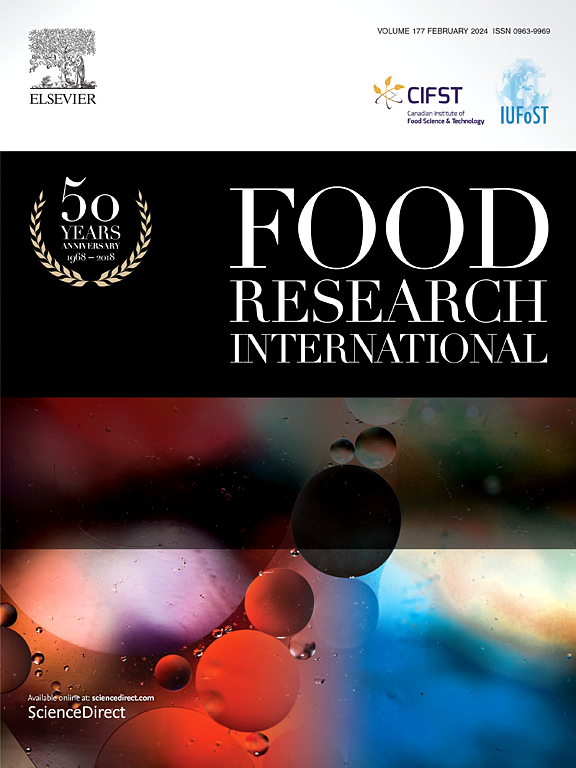From water-ice regulation to polysaccharides-protein assembly: Molecular mechanism of polysaccharides to improve the cryostability of gluten proteins
IF 7
1区 农林科学
Q1 FOOD SCIENCE & TECHNOLOGY
引用次数: 0
Abstract
The formation and recrystallization of ice crystals during freezing causes irreversible structural damage to the dough matrix, which is characterized by the cold denaturation of the gluten protein structure and the degradation of the gluten network structure. Polysaccharides are widely used to improve the quality of frozen dough owing to their excellent water-holding and viscosity. Current research has shown that polysaccharides mitigate the physical damage of ice crystals on the gluten protein structure mainly by modifying the water status of frozen dough to inhibit the ice crystallization process. However, recent evidence suggests that polysaccharide-regulated changes in water-ice dynamics are not the only mechanism underlying their cryoprotective effects, the self-assembly behavior of polysaccharides and gluten proteins driven by noncovalent forces also contributes to maintaining the stability of gluten protein structures. Therefore, starting from the deterioration mechanism of frozen dough, this review highlights the regulatory mechanisms of polysaccharides on the distribution and migration of water as well as ice crystal growth, and the formation mechanism of polysaccharide-gluten protein complexes based on polysaccharide-water interactions and polysaccharide-gluten protein interactions. Combined with the changes in the multiscale structure and aggregation properties of gluten proteins, we elucidated the cross-scale molecular mechanism of polysaccharides to improve the cryostability of gluten proteins through the dual pathway of “regulating water-ice dynamics to inhibit ice-crystal damage and promoting the molecular self-assembly behaviors to strengthen the structure of gluten proteins”, which will provide theoretical guidance for promoting of the quality improvement and industrialized production of frozen dough.

从水冰调节到多糖-蛋白质组装:多糖提高面筋蛋白低温稳定性的分子机制
在冷冻过程中,冰晶的形成和再结晶对面团基质造成不可逆的结构损伤,其特征是面筋蛋白结构的冷变性和面筋网络结构的退化。多糖由于其优良的保水性和黏性,被广泛用于改善冷冻面团的质量。目前的研究表明,多糖减轻冰晶对面筋蛋白结构的物理损伤主要是通过改变冷冻面团的水分状态来抑制冰晶的形成。然而,最近的证据表明,多糖调节的水冰动力学变化并不是其冷冻保护作用的唯一机制,多糖和面筋蛋白在非共价力驱动下的自组装行为也有助于维持面筋蛋白结构的稳定性。因此,本文从冷冻面团的变质机制出发,重点阐述了多糖对水分分布、迁移和冰晶生长的调控机制,以及基于多糖-水相互作用和多糖-面筋蛋白相互作用的多糖-面筋蛋白复合物的形成机制。结合面筋蛋白多尺度结构和聚集性质的变化,我们通过“调节水冰动力学抑制冰晶损伤和促进分子自组装行为增强面筋蛋白结构”的双重途径,阐明了多糖提高面筋蛋白低温稳定性的跨尺度分子机制。为促进冷冻面团的品质提升和工业化生产提供理论指导。
本文章由计算机程序翻译,如有差异,请以英文原文为准。
求助全文
约1分钟内获得全文
求助全文
来源期刊

Food Research International
工程技术-食品科技
CiteScore
12.50
自引率
7.40%
发文量
1183
审稿时长
79 days
期刊介绍:
Food Research International serves as a rapid dissemination platform for significant and impactful research in food science, technology, engineering, and nutrition. The journal focuses on publishing novel, high-quality, and high-impact review papers, original research papers, and letters to the editors across various disciplines in the science and technology of food. Additionally, it follows a policy of publishing special issues on topical and emergent subjects in food research or related areas. Selected, peer-reviewed papers from scientific meetings, workshops, and conferences on the science, technology, and engineering of foods are also featured in special issues.
 求助内容:
求助内容: 应助结果提醒方式:
应助结果提醒方式:


